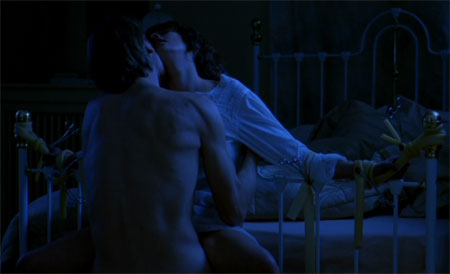I tend to cringe at depictions of BDSM in mainstream media, as it is usually flubbed in one way or another. Sometimes, however, a good (not necessarily “positive”) depiction appears in unexpected spots. For example, look at two films by Canadian director David Cronenberg.
Dead Ringers (1988) is about Elliot and Beverly Mantle, a pair of identical twin gynecologists. Elliot, the more extroverted brother, does the public relations side of their business. Beverly, the more introverted brother, does the actual work of research and surgery. Likewise, Elliot seduces the women who come into the clinic, and then passes the unsuspecting women on to Beverly when he tires of them.
When Claire, a famous actress, comes to the clinic for help with her infertility, Beverly is fascinated by her “fabulously rare” condition, a trifurcated cervix that makes her permanently infertile. Elliot keeps pushing the reluctant Beverly to see her.
Elliot: “If you don’t date her, I will. And I’ll do terrible things to her.”
Beverly: [pause] “What kind of terrible things?”
[transcribed from memory]

Cut to a shot of Claire bound to her bed with surgical tubing and clamps, with Beverly fucking her. As kinky as this is, it’s also intimate and touching.
Beverly and Claire are both very flawed people. He’s withdrawn, codependent and a repressed sadist. She’s a masochistic pill-popper fixated on having a child. And yet, their bondage sex creates a moment in which they can both open up to each other, express their greatest vulnerabilities in a controlled way, and achieve intimacy.
Claire and Beverly’s relationship does not go well after this: she leaves to work on another film, and Beverly goes completely to pieces and pulls his brother down with him. The bondage scene is actually related to the good parts of their relationship.
Cronenberg’s most recent film, A Dangerous Method, loosely reprises the premise of Dead Ringers: a pair of male scientific experts has their relationship tested by the woman they both become involved in. (The promotional posters of the two films even uses the same arrangement, with the woman’s face between the two men’s faces, merging into both.) In this case, the leads are Sigmund Freud, his heir apparent Carl Jung, and Sabina Spielrein, Jung’s patient-turned-protege-turned-collaborator, who is also his mistress.
(The movie is based on a non-fiction book, but I haven’t read it to see how historically accurate it is.)
Jung has a breakthrough with Spielrein when, on a walk in the woods, he picks up her discarded cloak and taps it with his cane to dislodge some leaves. Her reaction helps them figure out that she is sexually aroused by being beaten, a masochist. After her recovery and the beginning of her studies of psychoanalysis, they begin an affair, which includes her asking him to beat her.
Much like Claire and Beverly, this is a clear breach of medical ethics and psychiatric practice, not to mention Jung’s marriage vows (though perhaps not as big a deal in a time and place when mistress-keeping was commonplace). It’s also interfaith/interracial (he’s Protestant, she’s Jewish), and includes sexual acts that are socially and psychoanalytically improper. Nonetheless, it’s relationship that means a great deal to both of them, and provides a stimulus to both, emotionally and intellectually. It turns into an off-again-on-again affair over several years, with each of them breaking it off and then returning to the other.
Jung compares himself with Otto, a colleague of Freud who could be diagnosed as “honey badger don’t give a shit.” Otto just acts on impulse for immediate gratification, while Jung does things that are “wrong”, e.g. his affair with Spielrien, his rebellion against his mentor Freud, for a higher purpose. Or maybe the only real difference between Jung and Otto is that Jung feels hypocritical guilt about what he does.
A Dangerous Method ends with Freud, Jung and Spielrein having done things that are questionable, morally and ethically, but have made them who they are, made forward motion possible, made individual and social progress possible (maybe).
Perhaps the lesson to be learned from these films is that to create a part of our lives, where our most “primitive” and “wrong” sides of ourselves can run around a bit, with fences but not leashes, is better for us, both individually and collectively, than Freudian repression. In other words, BDSM.
In these cases, the BDSM grows out of the people’s psychologies, and forms one aspect out of many of their relationships. Compared to other depictions of BDSM in the mainstream, this is actually pretty good.




Sorry, the comment form is closed at this time.